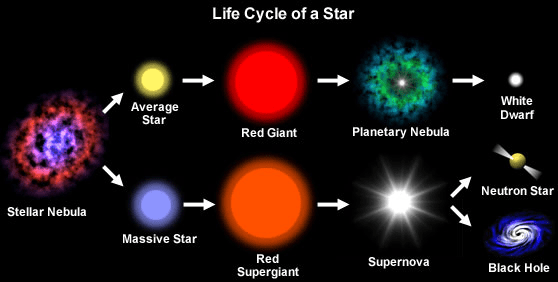We’re all made of star dust — an often-quoted phrase referring to the fact that nearly all the elements in the human body were forged in a star. But what are stars, themselves, made of?
Actually, stars are made of the same chemical elements as planet Earth, though not nearly in the same proportions. The vast majority of stars are made almost entirely of hydrogen (about 90%) and helium (about 10%) — elements that are relatively rare on our planet, and the lightest on the periodic table — while all the other elements represent just 0.1%.
“We know the first two elements of the periodic table – hydrogen and helium – were created in the Big Bang,” says Amanda Karakas, first author of a paper studying metal-rich stars.
“Over time, the stars that came after the Big Bang produce heavier elements.”
Among other elements, oxygen usually dominates, followed by carbon, neon, and nitrogen, with iron being the most common metal element. Still, there is only one atom of oxygen in the Sun for every 1200 hydrogen atoms and only one of iron for every 32 oxygen atoms.
It makes sense that hydrogen is the dominant element of the sun and other stars. In order to burn bright for billions of years, stars convert hydrogen into helium through a constant nuclear reaction similar to a hydrogen bomb. So, in a sense, the sun is in a state of a constant nuclear explosion and only appears as a solid sphere because it’s held together by its own massive gravity.
What’s more, as we’ll see, the composition and chemical makeup of stars can vary considerably depending on their states of aging or upon where they are in the galaxy. Even in the Milky Way, there is a great variety of star compositions.
“We have analysed in great detail the chemical composition of stars in three star-clusters and shown that each cluster presents a high level of homogeneity and a very distinctive chemical signature,” says ESO astronomer Gayandhi De Silva, who started research on this while working at the Mount Stromlo Observatory, Australia.
Also, elements other than hydrogen or helium can be forged by stars, but only towards the end of their life cycle. Typically, in a star such as the Sun, the heavier elements were seeded by stars that existed before it. Some stars go out with a bang, producing a supernova — a powerful and luminous explosion — during their last evolutionary stages, which ejects heavy elements into space. So new stars can incorporate this material. Due to the laws of physics, the universe recycles everything.
Not all stars glitter the same, nor are they made of the same stuff

All stars are amazing in their own way, but some shine more brightly than others. Hot stars appear white or blue when observed from Earth, whereas cooler stars appear in orange or red hues. Astronomers plot a star’s luminosity and temperature onto a graph called the Hertzsprung-Russell diagram, which is useful to classify stars.
Although there are many types of stars, the most common are main sequence stars — about 90% of all known stars, including the Sun, are in this class.
Below the main sequence stars are white dwarfs, the stellar core remnant after a star has exhausted all its fuel. These ancient stars are incredibly dense. A teaspoonful of their matter would weigh as much on Earth as an elephant.
Such densities are possible because white dwarf material is not composed of atoms joined by chemical bonds, but rather consists of a plasma of unbound nuclei and electrons. For this reason, nuclei can be placed closer than normally allowed by electron orbitals in normal matter.
Because white dwarfs are the remnant cores of normal stars, they are primarily made of the “waste” products of the nuclear fusion reactions that they used to support. These “waste” products are primarily carbon and oxygen, with traces of other elements. But that’s not to say there isn’t helium and hydrogen left. The outer part of a white dwarf contains the two elements. And due to the tremendous gravitational force associated with these dense stars, these elements are stratified with the heaviest elements residing at the deepest depths in the star.
Above the main sequence stars are ‘giants’ and ‘supergiants’. Before stars reach the very end of their evolution — when they turn into dwarfs or explode into supernovae — they condense and compact, heating up further as the last of their hydrogen is burned. This causes the star’s outer layers to expand outward. At this stage, the star becomes a large red giant.
According to an old study published in the 1985 edition of the Astrophysical Journal, red giants are mainly made of helium and hydrogen, along with carbon, oxygen, nitrogen, and iron. Astrophysicists also recorded the presence of heavy s-process elements such as strontium, yttrium, zirconium, barium, and neodymium.

Supergiants are among the most massive and luminous stars in the universe. Stars that are ten times bigger than the sun (or larger) will turn into supergiants when they run out of fuel. They are similar to red giants in composition except that they are, you guessed it, much larger.
The Sun is expected to turn into a red giant once it exhausts its fuel. Luckily, that won’t happen for another five billion years.
Overall, however, stars can be remarkably different from one another — as the places they are formed in are also very different from one another.
“We used to think that all stellar nurseries across every galaxy must look more or less the same, but a new survey has revealed that this is not the case, and stellar nurseries change from place to place,” said Adam Leroy, Associate Professor of Astronomy at Ohio State University (OSU), and lead author of the paper presenting the PHANGS ALMA survey.


